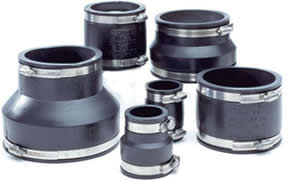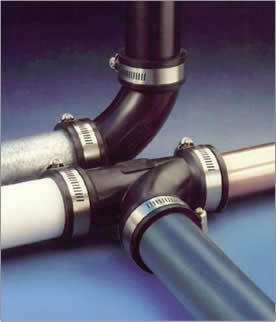When joining and repairing pipes it is often necessary to use a flexible pipe coupling, as shown in Figure 1, instead of a solid mechanical joint such as soldier, an adhesive or a female thread to a male thread.

Figure 1 - Flexible pipe couplings
There are many reasons that these situations occur:
- You are connecting different pipe materials together.
- You are connecting different diameter pipes together.
- You are creating a joint in the middle of a pipe and the pipe does not provide any room, due to its mounting to place a solid coupling in place.
- You have a pipe that has split and you cannot replace the piece due to physical constraints.
- You are connecting corrugated pipe to a solid surface pipe.
- You need an expansion joint due to changes in the length of the pipe because of temperature rise or decrease.
- You want to ensure the integrity of a joint and install a flexible coupling over the joint for protection.
The flexible couplings are usually made of a elastomeric PVC and held in place with stainless steel aviation clamps.

Figure 2 - Flexible "T" & "L" couplings
------------------------
- Convert Gallons to GPM
- Plumber’s Putty With Cultured Marble
- Copper Repiping
- Problems With Compression Fittings
- Flexible Pipe Couplings
- Cast Iron To PVC Pipe Connector
- Deglazing PVC Pipe
- New Washing Machine Causes Noise In Pipes
- Connecting Cast Iron To Pex Piping
- Tankless Water Heaters
- No Water Pressure From Well
- Avoiding Clogged Drains
- Clogged Drain
- Air Admittance Valves
- Sewer Gas Odor
- Understanding Plastic Pipe
- ABS Pipe Temperature/Pressure
- Operating Pressure For PVC Pipe
- Plumbing Vents
